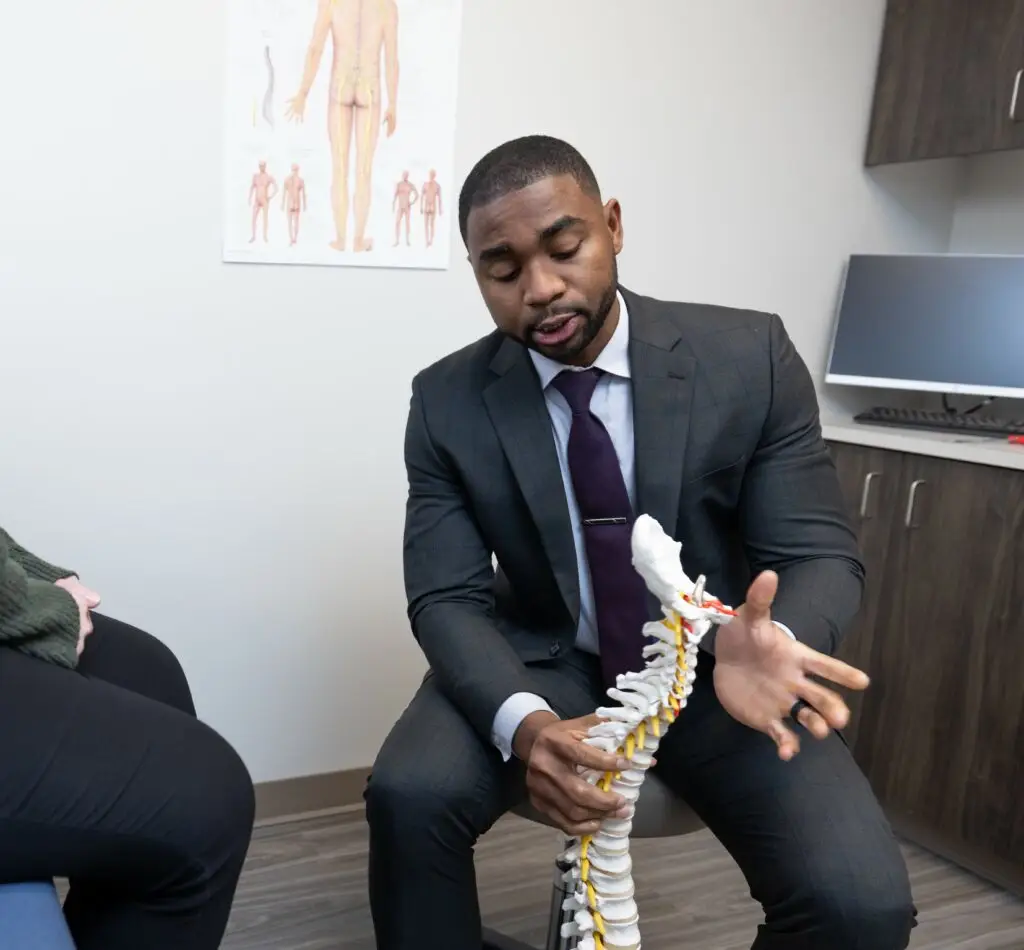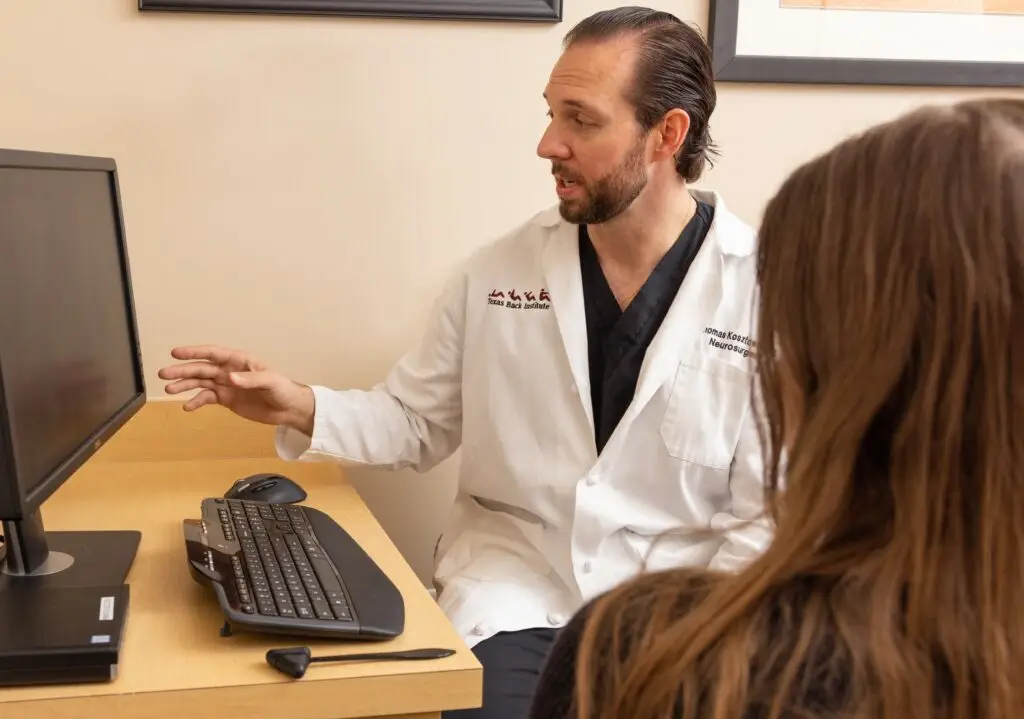What is Spondylolisthesis? How is it Related to Spondylosis and Spondylolysis?
how we can help
Spondylolisthesis Overview
The medical term Spondylolisthesis is derived from the Greek words “spondylus,” which is the word for spine or vertebra and “olisthesis” which means slipping or dislocation. This tongue twister – Spondylolisthesis – is a spinal condition that results from one vertebra in the spine slipping out of place and moving forward or backward in relationship to the vertebra below it. If it moves forward, it is called anterolisthesis; if it moves backward, it is called retrolisthesis.
Spondylolisthesis can occur anywhere along the spine, but it most often occurs in the low back, or lumbar spine. When a vertebra slips, the affected vertebrae creates spinal instability and may put pressure on a nerve, which could cause low back pain or leg pain that ranges from mild to severe. Some people with spondylolisthesis report no symptoms at all.
While spondylolisthesis can be present at birth it most commonly occurs in adulthood due to age-related “wear and tear” and in adolescence due to stress on the lower spine.
Table of Contents
Symptoms
Diagnosing
- X-ray: Identifies vertebral slippage and fractures.
- CT/MRI: Provides detailed views of spinal damage and nerve compression.
Treatments
Nonsurgical:
- Physical therapy and activity modification.
- NSAIDs and epidural steroid injections for pain relief.
Surgical:
- Spinal decompression and fusion for severe pain or nerve compression.
- Fusion surgery to stabilize and prevent further vertebral slippage.
Patients Ask:
What is Degenerative Spondylosis?
Texas Back Institute Responds: Also known as Degenerative Disc Disease, Spondylosis, a condition that usually occurs due to aging. As the term implies, it is the progressive deterioration of the discs between the vertebral bodies. Spondylosis (which is a different term than spondylolisthesis) is typically a degenerative condition of the joints of the spine and is also known as spinal osteoarthritis.
The most common type of spondylolisthesis is called degenerative spondylolisthesis. Adults may develop degenerative spondylolisthesis, the slipping of spinal vertebrae, due to Spondylosis.
Is Spondylolisthesis the Same Condition as a Slipped Disk?
In spondylolisthesis, a part of the vertebra slips out of place, so it is often confused with a slipped disk. However, they are different conditions.
A “slipped disk” usually refers to a herniated or ruptured disk. A herniated disk occurs when the soft inner core of a spinal disk, the nucleus, bulges out through a tear or rupture in the outer layer of the disk, the annulus. Intervertebral disks function as shock absorbers between the vertebrae, cushioning the bones in the spinal column and providing flexibility to the spine. Click here for a more in depth look at these injuries
As we age, the intervertebral disks that cushion vertebrae can become worn, dry out, and get thinner. Over time, this wear and tear on the disks can make it easier for the vertebra to slip out of place which can push up against the spinal canal and put pressure on the spinal nerve roots. Degenerative spondylolisthesis is the most common type of this condition. This abnormal movement or misalignment is also called spinal instability.
Patients Ask:
What Does a Slipped Disk Feel Like?
Texas Back Institute Responds: A “slipped disk” or herniated disk can cause sharp or severe back or neck pain. The pain can worsen with activity or when sitting for longer periods. It may cause pain, numbness, tingling, or weakness in different areas of the body, depending on which of the three spinal regions (cervical, thoracic, or lumbar) the disk is located.

Is Spondylolisthesis Different from Spondylolysis?
The medical term “Pars defect,” otherwise known as spondylolysis, is a fracture within the pars interarticularis of the vertebral arch in the spinal column. When spondylolysis leads to vertebral displacement, it is known as isthmic spondylolisthesis.
According to the American Academy of Orthopaedic Surgeons (hyperlink to article?), children and adolescents may develop spondylolisthesis from engaging in sports that require repeated lumbar extension, like wrestling, gymnastics, or football. L5 pars defect is a common cause of back pain in children and adolescents. Traumatic spondylolisthesis is another type of spondylolisthesis that is the result of trauma or injury to the spine often occurring from high contact sports. In most cases, the pars fracture occurs in adolescence and goes unnoticed until adulthood, with symptoms appearing in middle age.
Some cases of spondylolisthesis are the result of weak or defective vertebrae that have been present since birth. This condition is called congenital spondylolisthesis. Other causes include trauma and bodily injury, or a vertebra that is damaged by disease.
Patients Ask:
How Common is Spondylolisthesis?
Texas Back Institute Responds: The most common type of spondylolisthesis is degenerative related to disk thinning and aging. Found in 5-10% of the adult population, this condition is more prevalent after age 50 and more common in women than men.
What Are the Symptoms of Spondylolisthesis?
While it seems counterintuitive, there are patients who have spondylolisthesis and have no symptoms. Spondylolisthesis, in combination with other degenerative changes may result in compression of spinal nerves or the spinal cord. Symptoms will depend on multiple factors including the amount of nerve compression, which vertebrae are affected and the degree of slippage.
Mild cases may not present noticeable symptoms, while severe lumbar spine spondylolisthesis can cause:
- Low back pain
- Thigh pain
- Tenderness in the low back
- Tightness in the hamstring and buttock muscles
- Leg stiffness
Additionally, if slippage puts pressure on spinal nerves, patients may experience radiculopathy symptoms – numbness, tingling, pain, or weakness – in the legs.
In extreme cases, where the spinal nerves are significantly affected, cauda equina syndrome (link to TBI blog or condition page on the website) may occur. Symptoms of cauda equina syndrome include numbness in the groin area or down the legs, loss of bowel or bladder control, urinary urgency, and difficulty with balance or walking. Cauda equina is a spinal emergency. If you experience these symptoms, seek immediate medical evaluation.
If the slippage is found in the cervical spine, common symptoms can include:
- Neck Pain
- Radiating Pain
- Shoulder Blade Pain
- Headaches originating from the back of the neck
- Difficulty Holding Objects
How is Spondylolisthesis Diagnosed?
A Texas Back Institute spine specialist will complete a medical history and conduct a physical examination to assess the mobility of the spine and any signs of nerve compression. A neurological exam may be required to evaluate reflexes and muscle strength, although with spondylolisthesis, the neurological exam findings are typically normal.
An x-ray of the lumbar spine will reveal cracks, fractures, or slippage of vertebra. A CT scan provides images of the bones and soft tissues to determine damage or abnormalities and an MRI, or a myelogram may be necessary to assess the level of nerve root or spinal cord compression. Degenerative Spondylolisthesis is the most common type and mostly occurs at L4-L5. L5-S1 is the most common site of Isthmic Spondylolisthesis.
A grading system for spondylolisthesis can classify the condition based on the amount of vertebral slippage and is sometimes used in determining the best course of treatment for a patient. The terms “anterolisthesis” and “retrolisthesis” are specific types of spondylolistheses that differentiate the direction of slippage. Anterior slippage is more common than posterior slippage.
A lateral imaging view is used for grading. Flexion and extension views may be done to check for increased angulation and forward movement. Doctors may recommend different treatments dependent on the stage of the disease.
The most widely used grading system is the Meyerding classification.
- Grade 1 spondylolisthesis is the least severe case. The degree of slippage for spondylolisthesis grade 1 ranges from 0%-25%. Grade 1 anterolisthesis (forward displacement) usually occurs in the L4 on the L5 segment of the spine, which is connected to the facet joints.
- Grade 2 spondylolisthesis is like grade 1, with a degree of slippage that ranges from 26-50%.
- Grade 3 spondylolisthesis is more severe, with a degree of slippage ranging from 51 -75%.
- Grade 4 spondylolisthesis is severe, with a degree of slippage ranging from 76%-100%.
- Grade 5 is when the vertebra has completely fallen off the next vertebra. This rare condition is known as spondyloptosis.

Patients Ask:
What risk factors contribute to Spondylolisthesis?
Texas Back Institute Responds: There are several risk factors that contribute to the onset of this condition, such as age, heredity, gender, obesity, smoking, and high-impact sports. Congenital defects, other spine conditions that weaken the spine joints and ligaments, and repetitive trauma are also risk factors.
Spondylolisthesis Treatment
Although nonsurgical treatment will not repair vertebral slippage, many patients report that the following treatments have helped to alleviate their symptoms.
- Physical therapy and exercise: Specific exercises to stretch the low back and abdominal muscles.
- Activity Modification: Limit back-bending movements, lifting heavy weights, and other high impact activities
- Medication: Analgesics and non-steroidal anti-inflammatory drugs
- Epidural Steroid Injections: Steroids to reduce inflammation around nerves, alleviating pain
Nonsurgical treatments, such as physical therapy, reducing activity, and corticosteroid injections, can provide relief from pain and symptoms without the need for surgical intervention. When nonsurgical treatments fail to alleviate symptoms, or if the severity of your symptoms warrant it, spinal surgery, such as spinal decompression and fusion, may be considered to address the severity of the condition.
Spinal Fusion Surgery
According to the American Academy of Orthopaedic Surgeons, “if you have degenerative spondylolisthesis and your symptoms have not improved after 3 to 6 months of nonsurgical treatment, your doctor may recommend surgery, particularly if you are unable to walk or stand and the pain and weakness negatively affect your quality of life. Your doctor will also consider the extent of arthritis in your spine and whether your spine has excessive movement.”
For cases with severe pain not responding to therapy, if the slip is severe or there are neurologic changes, the slipping vertebra might be surgically fused to the vertebra below it. Basically, spinal fusion surgery is performed to eliminate painful motion and restore spinal stability by fusing together two or more vertebrae using small pieces of bone graft so that they heal into one solid bone. A spinal surgery is considered only after all conservative care measures fail to provide significant pain relief.
Patients Ask:
How long does it take to recover from spinal fusion surgery?
Texas Back Institute Responds: After spinal fusion surgery, the overall recovery period can extend over several months. Full healing and the ability to resume all activities, particularly physically demanding ones, may require up to a year, depending on the overall health of the patient.
There is an excellent possibility for optimal results by following a surgeon’s post-operative instructions. If you have a brace or if your physical therapist has given you assistive devices to help with recovery, use them. Lifestyle adaptations like getting a good night’s rest, maintaining a healthy weight, and eating a nutritious diet will help ensure optimal healing benefits.
Help is Available
If back pain is interfering with your quality of life, it might be time to talk to an expert at Texas Back Institute and set an appointment.
Learn more
Frequently Asked Questions
Also known as Degenerative Disc Disease, Spondylosis, a condition that usually occurs due to aging. As the term implies, it is the progressive deterioration of the discs between the vertebral bodies. Spondylosis (which is a different term than spondylolisthesis) is typically a degenerative condition of the joints of the spine and is also known as spinal osteoarthritis.
The most common type of spondylolisthesis is called degenerative spondylolisthesis. Adults may develop degenerative spondylolisthesis, the slipping of spinal vertebrae, due to Spondylosis.
A “slipped disk” or herniated disk can cause sharp or severe back or neck pain. The pain can worsen with activity or when sitting for longer periods. It may cause pain, numbness, tingling, or weakness in different areas of the body, depending on which of the three spinal regions (cervical, thoracic, or lumbar) the disk is located.
The most common type of spondylolisthesis is degenerative related to disk thinning and aging. Found in 5-10% of the adult population, this condition is more prevalent after age 50 and more common in women than men.
There are several risk factors that contribute to the onset of this condition, such as age, heredity, gender, obesity, smoking, and high-impact sports. Congenital defects, other spine conditions that weaken the spine joints and ligaments, and repetitive trauma are also risk factors.
After spinal fusion surgery, the overall recovery period can extend over several months. Full healing and the ability to resume all activities, particularly physically demanding ones, may require up to a year, depending on the overall health of the patient.
Locations


